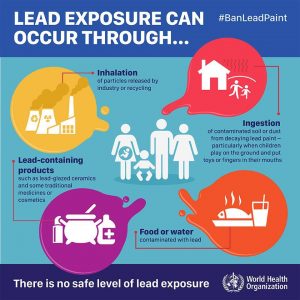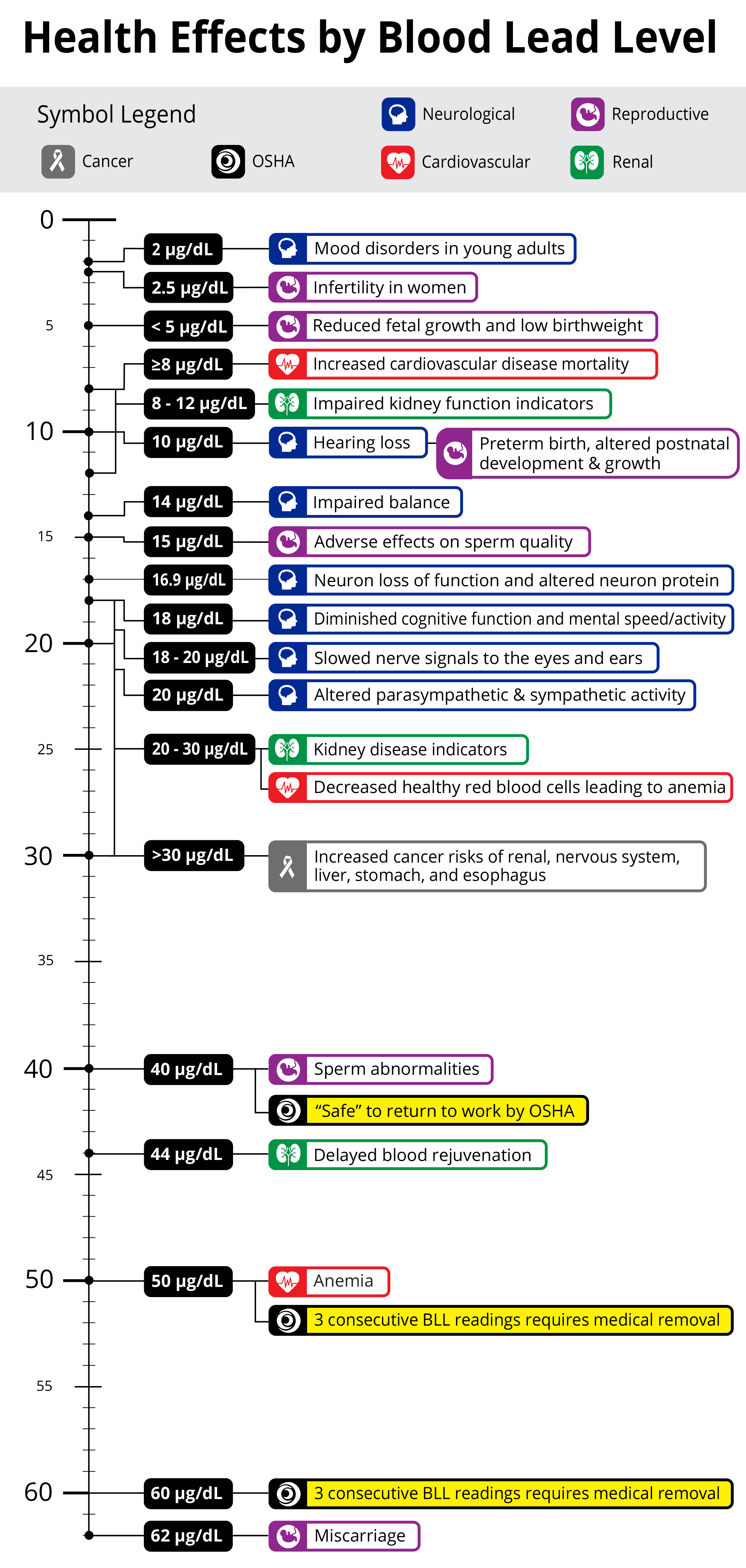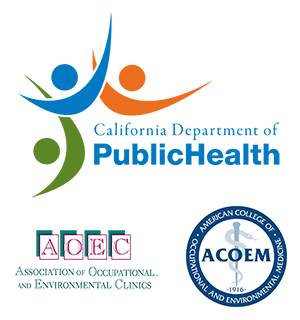
Lead Concentrate (Source)
National Institute for Occupational Safety and Health (NIOSH) announced in August 2018 that the agency intends to re-evaluate and possibly update the recommended exposure limit (REL) for inorganic lead (Ref. 1). NIOSH currently recommends the same exposure level for inorganic lead as OSHA, 50 µg/m3, which was set in 1978 and has not been changed since (Ref 2). Also, other safety organizations, such as the American College of Occupational and Environmental Medicine (ECOEM) and the California Department of Health, have requested that OSHA update legally mandated PELs in order to adequately protect employees against lasting health effects (Ref. 3). An abundance of scientific studies have confirmed the harmful health effects of inorganic lead exposure below the recommended limit. Employers should safeguard employee health to minimize exposure to inorganic lead as much as possible to prevent lasting health effects.
Exposure to Inorganic Lead

Methods of Inorganic Lead Exposure (Source)
Exposure to inorganic lead occurs through inhalation or ingestion. Inorganic lead body absorption typically can be measured by the blood lead level. However, the blood lead level only adequately measures recent lead exposure because of a 36 day half-life of lead in blood (Ref. 4). After a period of time the blood lead levels drop while lead deposits into the bone. When lead enters the body, the respiratory system takes in about 50% of lead. Then, about 2-5% of lead stays in the blood while the bone absorbs about 90% of the lead (Ref. 5, p. 35). After lead stores in the bones, lead can leave the bone and reenter other body systems re-exposing the body to lead. The absorption of lead in the bone can be measured with the cumulative bone lead level or the bone lead concentration. These factors represent long-term exposure of inorganic lead.
Comparatively, the majority of exposure to inorganic lead occurs on an occupational level. After the restriction of lead in gasoline, paints, food cans, and other consumer goods, the mean blood lead level in the general population has fallen from 12.8 µg/dL to 1.09 µg/dL (Ref. 3). As a matter of fact, OSHA estimates that about 804,000 workers in the general industry and 838,000 workers in the construction industry are potentially exposed to inorganic lead (Ref. 6). Employees come in contact with inorganic lead when using, repairing, or manufacturing lead-based products including solders, bullets, brass, and radiators (Ref. 7). Also, construction workers while renovating old facilities, made before the ban of lead in paint and building supplies, may be exposed to inorganic lead at dangerous levels (Ref. 6). Additionally, soldering, welding, and flame torch cutting operations may come in contact with inorganic lead depending on the material content of the metal or solder (Ref. 7). Uniquely, firing ranges with lead bullets endanger workers and shooters to inorganic lead hazards (Ref. 6).
Harmful Health Effects of Inorganic Lead Exposure
Mainly, for short term exposure, OSHA requires that employees with a blood lead level of 60 µg/dL or 3 consecutive readings of 50 µg/dL result in removal from working conditions and may return to work once the blood lead level goes down to below 40 µg/dL (Ref. 5, p. 3). Blood lead levels as low as 5 µg/dL to 40 µg/dL provoke dangerous health effects to employees. Blood lead levels below 40 µg/dL can cause “impaired neurologic, hematopoietic, renal, reproductive, and cardiovascular” functioning (Ref. 5, p. 118).
For example, in a study conducted by the National Research Council for the Department of the Defense, strong evidence indicated that inorganic lead exposure created destructive side effects below the established OSHA PEL (Ref. 5). See the graphic below illustrating the numerous health effects from inorganic lead exposure (Ref. 5). The labels marked in yellow indicate the current levels that OSHA recognizes as the cutoff point (Ref. 5). This graphic clearly demonstrates the severity of conditions of blood lead levels below 40 µg/dL, the level OSHA considers ‘safe’ to return back to work.

Furthermore, long term inorganic lead exposure, measured by bone lead level, generates persisting health effects similar to elevated blood lead levels, but in addition: depression, increased cardiovascular mortality, increased cancer risks, decreased neurological functioning and ischemic heart disease (Ref. 5, p. 119). OSHA does not consider bone lead level or bone lead concentration in the PEL, but the bone lead level provides critical insight to determine persisting health effects.
Similarly, elevated lead levels have been shown to possibly increase cancer risks. The Department of Health and Human Services states that inorganic lead is “reasonably anticipated” to be a human carcinogen (Ref. 8). The FDA describes inorganic lead as a probable human carcinogen as well as the International Agency for Research on Cancer (Ref. 8). Animal studies back up these statements with evidence of the growth of tumors on the kidney, brain, lung, and of the hematopoietic system, or the blood cell production system (Ref. 5, p. 105). Human studies do support these assertions; however, the studies lack proper control and exposure methods providing little concrete evidence to back up the relation between inorganic lead exposure and increased cancer risks (Ref. 5, p. 106).
Inorganic Lead Exposure Limit Recommendations
With this intention, many safety organizations have advised OSHA to review the PEL and update it to a safer airborne concentration that results in a less elevated blood lead level and bone lead level.
First, the California Department of Public Health urged the California division of OSHA to update the blood lead level to be below 5-10 µg/dL with an airborne limit of 0.5-2.1 µg/m3 (Ref. 2). This recommendation would reduce the current REL by about 95% and minimize unsafe effects.
At the same time, the Association of Occupational Environmental Clinics (AOEC) advocates for the blood lead level to be below 20 µg/dL with an average of 10 µg/dL over a 40 year period to prevent lifelong damaging side effects (Ref. 5, p. 121). The AOEC advises for pregnant women or women expecting to become pregnant to maintain a blood lead level of below 5 µg/dL to prevent damage to the developing fetus (Ref. 5, p. 121). Likewise, the American College of Occupational and Environmental Medicine (ACOEM) agrees with the AOEC on the proposed blood lead level limit, but also urged any exposure level that is known to cause elevated blood lead level is considered significant regardless of the airborne inorganic lead concentration (Ref. 3).
Important to realize, the ACOEM urges employers to not wait for government regulations to catch up to scientific health research and protect employees against inorganic lead exposure as much as feasibly possible.
Inorganic Lead Exposure Prevention Solutions
In order to properly preserve employee respiratory health and shield from unsafe inorganic lead exposure, the National Research Council endorses improving workplace ventilation (Ref. 5, p. 121). Sentry Air Systems manufactures high-quality filtration systems that provide an economical way to control inorganic lead exposure, unlike expensive standard systems. Our systems present a portable, easy to install and implement a solution because they do not require costly ductwork.
Depending on the process, Sentry Air Systems can suggest a system suited to protect employee respiratory health from inorganic lead exposure.
Portable Welding Fume Extractor – SS-300-WFE
Heavy Duty Industrial Welding Fume Extractor – SS-500-WFE-MP1
Stainless Steel Solder Sentry – SS-100-SS-ST
Ambient Air Cleaner – SS-700-FH
Contact us today to learn how filtration systems can protect your employees from inorganic lead exposure.
Call us to discuss solutions to control inorganic lead in your workspace — 1.800.799.4609
Sources
1. NIOSH to Reevaluated Recommended Exposure Limit for Inorganic Lead.” The Synergist. 22 Aug 2018. https://www.aiha.org/publications-and-resources/TheSynergist/Industry%20News/Pages/NIOSH-to-Reevaluate-Recommended-Exposure-Limit-for-Inorganic-Lead.aspx.
2. Schillaci, William. “OSHA’s 40-Year-Old Lead Standard Is Far Short of Protective.” EHS Daily Advisor. 18 Jul. 2018. https://ehsdailyadvisor.blr.com/2018/07/oshas-40-year-old-lead-standard-far-short-protective/.
3. Holland, Michael and Cawthon, David. “Workplace Lead Exposure.” ACOEM Position Statement. Volume 58, Number 12, Dec. 2016. http://www.acoem.org/uploadedFiles/Public_Affairs/Policies_And_Position_Statements/Guidelines/Position_Statements/Workplace_Lead_Exposure.pdf.
4. “Why Measure Lead in Bone?” Mount Sinai School of Medicine. http://research.mssm.edu/xrf/why.html.
5. “Potential Health Risks to DOD Firing-Range Personnel from Recurrent Lead Exposure.” National Research Council. Dec. 2012.
https://www.eenews.net/assets/2012/12/04/document_daily_01.pdf.
6. “Safety and Health Topics: Lead.” Occupational Safety and Health Administration. https://www.osha.gov/SLTC/lead/.
7. “Protecting Workers from Lead Hazards.” OSHA Fact Sheet. Sept. 2005. https://www.osha.gov/OshDoc/data_Hurricane_Facts/LeadHazards.pdf.
8. “ToxFAQs for Lead.” Agency for Toxic Substances and Disease Registry. Aug. 2007. https://www.atsdr.cdc.gov/toxfaqs/tfacts13.pdf.

 Made in the USA
Made in the USA




